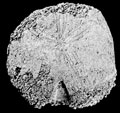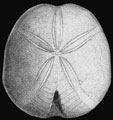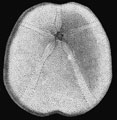D'Orbigny (1856, p. 291) had published only a table in which this name appears without diagnosis. This is thus a nomen nudum. The first diagnosis of the taxon ciome in Desor (1858, pp. 249, 263, 273, 275, 279, 435, 489) which thus establishes the genus. Cotteau (1858, p. 422) subsequently described the genus following d'Orbigny's death.
Clypeopygus is most like Nucleolites, both genera having similar petals and periproct. The type species differ in that the test of Clypeopygus is more depressed (Kier, 1962, p. 70) with a notched anterior margin, has a sharply pointed anal sulcus and phyllodes where the pore-pairs have a loop-like arrangement. This loop-like arrangement is also found in the phyllode of Catopygus, being distinctly different from the type species of Nucleolites where the pore-pairs occur as two parallel series.
Kier (1962, p. 70) states that although Lambert & Thiery (1909-1925) refer many species to this genus, few of the post-Cenomanian species, if any, belong to this genus.
G. Cotteau. 1853-1855. Paleontologie francaise ou description de fossiles de la France. Terrain Cretace. Tome VI. Echinoidea. G. Masson, Paris. 598 pp., pls. 801-1006.
J. Lambert & P. Thiery. 1909-1925. Essai de nomenclature raisonnee des echinides. Libraire Septime Ferriere, Chaumont, 607 pp., 15 pls.
P. M. Kier. 1962. Revision of the cassiduloid echinoids. Smithsonian Miscellaneous Collections, 144 (3) 262 pp.
Orbigny, A. d' 1854-60. Paléontologie Française. Terrains Crétacés. Tome 6. Echinodermes, Échinoides irréguliers. 596 pp, pls 801-1006. G. Masson, Paris. 1-32 (July 1854); 33-64 (Oct. 1854); 65-96 (Nov. 1854); 97-128 (Jan. 1855); 129-192 (Mar. 1855); 193-208 (May 1855); 209-224 (Aug. 1855); 225-272 (Nov. 1855); 273-320 (Oct. 1856) pp. 273-352 (Oct. 1856), pp. 353-384 (1857), pp. 385-400 (1858), pp. 401-432 (1858), pp. 433-596 (1860).




